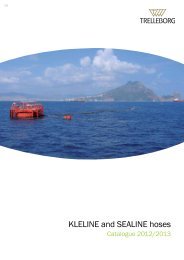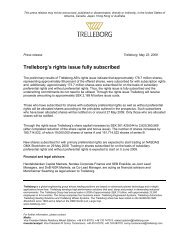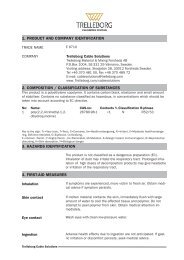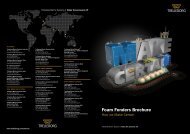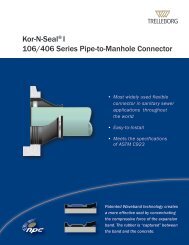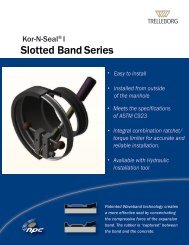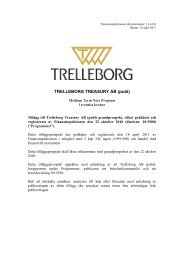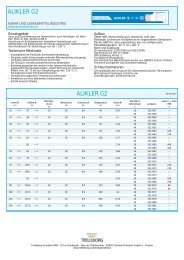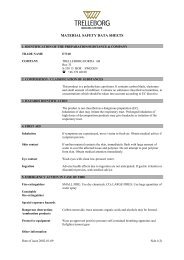W9U-I Injectable Waterstop - Trelleborg
W9U-I Injectable Waterstop - Trelleborg
W9U-I Injectable Waterstop - Trelleborg
You also want an ePaper? Increase the reach of your titles
YUMPU automatically turns print PDFs into web optimized ePapers that Google loves.
Tools<br />
The injection tool has to be equipped with a clear manometer with a maximum range of 100<br />
bar. Preferably the maximum pressure has to be adjustable. The fluids should be mixed<br />
mechanically according to regulations of supplier.<br />
Injection procedure<br />
The usage of injection resin depends on the number of gravel spots. Experience in practice<br />
result in a mean usage of 0,2 -0,4 litre/meter.<br />
1. Check if the injection tubes are clean and dry.<br />
2. Starting point of the injection should be in the middle of the floor of the tunnel.<br />
3. Injection is done with two injection teams<br />
4. Team A works to right side and team B works to left side, starting with the floor, then the<br />
walls and finally the roof<br />
5. One joint has to be injected in one phase, therefore make sure there are sufficient spareparts.<br />
6. From the first injection point there has to be injected until the epoxy-resin is shown at the<br />
next injection pipe (maximum pressure = 10 Bar).<br />
7. As soon as the epoxy-resin leaves the next injection pipe, the first injection point should be<br />
shut. Injection should go on from the second injection point. In case the epoxy-resin<br />
exceeds a pressure of 10 bar during 2 minutes one should also close this injection point and<br />
proceed from the next pipe.<br />
8. When from the second injection point the epoxy-resin proceeds from the third injection<br />
point one should close the third injection pipe with a dome nut and go on with injection<br />
from the second point. All the following injection points from which the fluid is coming out<br />
should be shut. In case the proceeding epoxy-resin is coloured white one should wait with<br />
closing the injection pipe until the epoxy-resin has got its natural colour. The white colour<br />
shows that water is mixed with epoxy-resin.<br />
9. As soon as the pressure will become higher as 10 Bar, close the injection point and proceed<br />
at the latest point where the fluid has been shown.<br />
10. If leakages in the dilatation joint are suspected, injection should be stopped until the epoxyresin<br />
is transformed into a gel. Thereafter the pressure can be increased slowly while<br />
checking if the leakage has stopped.<br />
11. If not, extra holes should be drilled to the end of the waterstop and injection should be<br />
started from the extra holes with smaller distances.<br />
12. If during injection-operation no leakages has appeared and the epoxy resin is not leaving<br />
the injection pipes one should drill at 1 meter from the last injection-pipe a hole to the<br />
sponge of the waterstop, and check if there’s epoxy-resin.<br />
13. If not the injection should take place from the new drilled hole (after closing the injection<br />
pipe). If there is epoxy resin, drill a new hole at a distance of 1 meter and repeat the<br />
procedure.<br />
14. After total operation the injection pipes can be shortened and the injection-space can be<br />
filled with mortar.<br />
10/07 7




